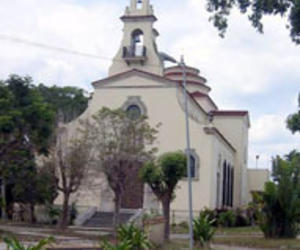The Catalan legacy in Havana
- Submitted by: manso
- Editorial Articles
- 02 / 24 / 2011

2011.02.23 - 09:25:43 / radiorebelde.The Catalan legacy in Havana. Havana, Cuba. - Deep historical and family bonds unite the Cuban and Catalonian peoples. These roots merge to form only one tree and leave their “multiple and fertile” mark. Part of that material heritage is the Church of Our Lady of Montserrat.
Better known as The Catalonians’ Chapel, it stands at the 8 ½ kilometer of Rancho Boyeros avenue. This church has nurtured the dreams and fantasies of thousands of people that drive along this popular artery of the Cuban capital every day. It stands on a hilltop, surrounded by luxuriant trees that make it look like floating in the clouds.
The history of this temple goes back to 1885, when Father Pere Muntadas and board members of Havana Catalonian Center and other associations, embraced the idea of building a church dedicated to the Virgin of Montserrat.
According to the documents of those days, a committee was created to find a place that resembled the Montserrat Mountain in the Cuban Island. The committee in charge of these actions chose the Tadino Hill, which has seen been called the Montserrat or Catalonian’s Hill.
Soon after, a popular fund-raising was opened to build and decorate the church. The first stone of the chapel was laid in 1886, but numerous setbacks delayed its delivery until July 24 1921. It was built in the plot of land where the “Jose Marti Memorial” stands today, at the Revolution Square.
The Church of Our Lady of Montserrat lasted shortly in that area, because in 1951, the state expropriated the lands of the chapel to build the so-called Civic Square and the monument to Jose Marti.
When the building was demolished, the Catalonian Charity Society could only recover a few pieces of marble, the shrine, the virgin, the stained-glass and the lead windows that are currently part of the temple.
In the first months of 1951, land preparation started to build the new church in a plot of land that was bought for that purpose. Architects Vicente J. Salles and Francisco G. Padilla were in charge of the works. The model to follow was the Church of S’ Agaró, in Catalonia, regarded as a genuine representation of Mediterranean architecture.
The current Catalonian’s Chapel was finished in 1954. It consists of 3 naves and is 28 meters long with a facade 22 meters high.
Many say that the Chapel summarizes the presence of Catalonians in the largest Antillean Island. Nowadays, worshippers of the Virgin of Montserrat still go to the church to attend mass and other religious ceremonies. The April Rose Party also takes place there, where men and women carry in their chest the symbolic flower, as a token of faith and hope. By: Elsa Maria Cortes
Comments